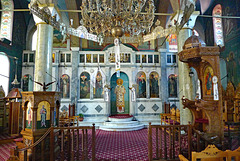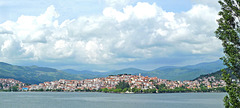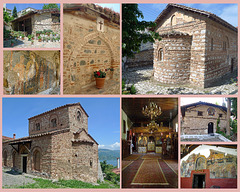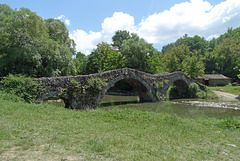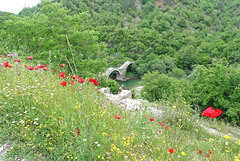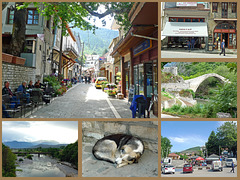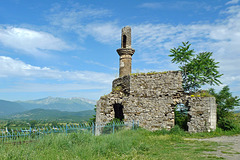
Greece - Ελλάδα - Griekenland
Greece - Kamarina, Agios Dimitrios monastery
| |
|
|
|
It is not exactly known when the Agios Dimitrios monastery was founded. The interior of the church is filled with murals from 1816, as a sign on the west gate indicates. Another sign above the gate of the monastery mentions the date February 27, 1831. Presumably around that time the rest of the monastery complex was built.
The monastery is located at the foot of Mount Zalongo, below the monument with the same name. There are still a couple of nuns living in the monastery. One of them welcomed us with the traditional “loukoumia” (oversweet candy).
Greece - Karpenisi, Holy Church of the Virgin Mary
| |
|
|
|
The Holy Church of the Virgin Mary (Ιερός Ναός της Παναγίας) is one of the five large churches in the the town of Karpenisi. The Virgin Mary Church was the cathedral during the Turkish occupation. In July 1821 all churches were destroyed and/or burned down.
After the burning of the churches and the whole town of Karpenisi by the Turks in 1821, the people began to settle down again. Their primary goal was to rebuild their churches and school. Each parish was interested in its own hurch and was doing an enviable activity. The present Holy Church of the Virgin Mary was built in 1910 and it is the fourth time that the church has been built on the same site.
Greece - Κleidonia Bridge
| |
|
|
|
After an unsuccessful attempt in 1844, finally the Kleidonia (also Klidonia) Bridge was built in 1853. This one-arch bridge spans the Voidomatis river in a verdant valley. The construction was paid by Balkiz Hanum, spouse of the Turk Malik-pasha.
The elongated arch has a length of 20 meters and a height of 9.15 meters. The path over the bridge is 3,20 meters wide. The bridge is considered being the end of the Vikos Gorge .
The Kleidonia Bridge is not only known for its beautiful arch, its location among plane trees and scenic views, but also boasts of a history of a bloody feud between two families for reasons of honor.
Greece - Karpenisi, Agia Triada Church
| |
|
|
|
The Agia Triada Church - just a few meters far from the central square - is dating back to the second half of the 16th century, when a smaller church was expanded.. The church is a listed historic monument. It was severly damaged by Turks and destroyed in 1684, but rebuilt in 1693. The church was then completely destroyed in 1756, in a attack known in history as the “Destruction of Karpenisi”. Subsequently, in 1821 it experienced the wrath of the Turks as it was set on fire along with the other churches of the town.
The Agiada Triada Church took its current form in 1960 and since then stands tall and welcoming the faithful of the town.
Greece - Kastoria
| |
|
|
|
Kastoria is partly built on a narrow peninsula jutting into Lake Orestiada at an altitude of about 630 meters. The small city is tucked away in the mountains of Macedonia. The place was first mentioned in the 1st century AD as Celerum, a town which was captured by the Romans during their war against Phillip V of Macedon in 200 BC.
The name Kastoria was first referred to in the late 10th century, when it was held by Bulgaria during the Byzantine-Bulgarian wars. Most probably Kastoria derives from the Greek word kástoras , meaning beaver.
Trade in the fur was traditionally an important element of Kastoria’s economy. The trade in beaver skins, which began over a thousand years ago, gave rise to the towns chief industry. When the beavers from the lake ran out, the town imported furs. Nowadays Kastoria still is an (international) center for the fur trade and offers many fur and leather shops/showrooms.
Kastoria is well known for its many churches and monasteries. From the 72 Byzantine and medieval churches there are still 52 in and around the city. Many of them have frescoes that are in very good shape. One of the most beautiful and interesting is Monastery Panagia Mavriotissa ( www.ipernity.com/doc/294067/47511956 ), located on the shores of Lake Orestiada.
Lake Orestiada (or Lake Kastroria), the promenade and forests offer a perfect shelter for all kind of bird species. The lake is home for 200 different species, among them some rare and endangered ones. The most typical species are cormorants, pelicans, herons, swans, wild ducks and herons. Lake and surrounding wetlands also house frogs and Greek turtles.
Greece - Kastoria
| |
|
|
|
Kastoria is partly built on a narrow peninsula jutting into Lake Orestiada at an altitude of about 620 meters. The small city is tucked away in the mountains of Macedonia. The place was first mentioned in the 1st century AD of a town near a lake called Celerum, a town which was captured by the Romans during their war against Phillip V of Macedonoa in 200 BC.
The name Kastoria was first referred to in the late 10th century, when it was held by Bulgaria during the Byzantine-Bulgarian wars. Most probably Kastoria derives from the Greek word kástoras , meaning beaver.
Trade in the fur was traditionally an important element of Kastoria’s economy. The trade in beaver skins, which began over a thousand years ago, gave rise to the town’s chief industry. When the beavers from the lake ran out, the town imported furs. Nowadays the fur trade has almost stopped.
Kastoria is well known for its many Byzantine churches and monasteries. From the 72 Byzantine and medieval churches there are still more than fifty in and around the city. Many of them have frescoes that are in very good shape. One of the most beautiful and interesting is Monastery Panagia Mavriotissa, located on the shores of Lake Orestiada.
Lake Orestiada (or Lake Kastoria), the promenade and forests offer a perfect shelter for all kind of bird species. The lake is home for 200 different species, among them some rare and endangered ones. The most typical species are cormorants, pelicans, herons, swans, wild ducks and herons. Lake and surrounding wetlands also house frogs and Greek turtles.
Greece - Kastoria, Doltso
| |
|
|
|
In Ottoman times, Kastoria attracted a mass of people from all over the Balkans and beyond, resulting in a diverse, multi-ethnic community. The different ethnic communities, Bulgarian, Turkish, Greek and Jewish, were centred around separate neighbourhoods or 'quarters'. Two old lakeside Greek neighbourhoods "Doltso" and "Apozari" are among the best-preserved and last remaining traditional quarters of the city.
Especially “Doltso” - with its cobbled alleys and streets - is characterised by historic traditional mansions so called archontika - and houses, built between the 17th and 19th centuries by wealthy Kastorian furriers. During this time, the processing and exporting of animal furs created wealth in Kastoria.
Some of these mansions nowadays houses museums and hotels.
Greece - Kastoria, (post)-Byzantine churches
| |
|
|
|
Kastoria is well-known for its churches. It is also calles “city of 100 churches”. The amount of Byzantine and post-Byzantine churches proves the richness of the city through the different ages. Kastoria originally had 72 Byzantine and medieval churches, of which 54 have survived. Some of them have been restored and provide useful insight into trends in late Byzantine styles of architecture and fresco painting.
Many of the churches are small structures, as they were built as private churches by wealthy fur traders or the katholika of small monasteries. They are either aisleless churches or three-aisled basilicas. Their façades often show rich masonry with decorative letters, geometrical patterns, bands of dentils and occasional sun motifs. The churches also have outstanding fresco decorations with diverse iconographic programmes, showing their donors’ and painters’.
Greece - Kastoria, Monastery Panagia Mavriotissa
| |
|
|
|
The monastery Panagia Mavriotissa was founded in 1082/83 by Byzantine Emperor Alexios I Komnenos to commemorate the victory over the Normans and the recapture of Kastoria.
It is referred to in documents dating back to the 13th century as the monastery of Panagia Mesonisiotissa (= in the middle of the island). In the second half of the 17th century the name changed to Panagia Mavriotissa, because the inhabitants of the village of Mavrovo (nowadays ‘Mavrochori’) ensured that it remained in good condition.
The monastery played an important role in the history of the area, but remained closed for many years. It was reopened in 1998. Only a few buildings from the original monastery have survived. The church has a spacious narthex on the west side, which was added later. The interior is decorated with murals dating from the beginning of the 13th century. The icons on the outside date from the period 1259 - 1264.
The murals and drawings were damaged - all eyes of saints were removed - during Ottoman period. Some of these old frescoes were restored in the 13th century, while the outer wall of the narthex was decorated with new ones.
Pangia Mavriotissa is located at a beautiful location with very old platanus trees, at the banks of Lake Orestiada, at a distance of four kilometers from Kastoria ( www.ipernity.com/doc/294067/47608732 ) and opposite the village Mavrochori. The monastery is dedicated to the Dormition of the Virgin. A chapel dedicated to John the Theologian, with wall-paintings executed in 1552 was erected beside it in the 16th century.
Greece - Kastoria, Monastery Panagia Mavriotissa
| |
|
|
|
The monastery Panagia Mavriotissa was founded in 1082/83 by Byzantine Emperor Alexios I Komnenos to commemorate the victory over the Normans and the recapture of Kastoria.
It is referred to in documents dating back to the 13th century as the monastery of Panagia Mesonisiotissa (= in the middle of the island). In the second half of the 17th century the name changed to Panagia Mavriotissa, because the inhabitants of the village of Mavrovo (nowadays ‘Mavrochori’) ensured that it remained in good condition.
The monastery played an important role in the history of the area, but remained closed for many years. It was reopened in 1998. Only a few buildings from the original monastery have survived. The church has a spacious narthex on the west side, which was added later. The interior is decorated with murals dating from the beginning of the 13th century. The icons on the outside date from the period 1259 - 1264.
The murals and drawings were damaged - all eyes of saints were removed - during Ottoman period. Some of these old frescoes were restored in the 13th century, while the outer wall of the narthex was decorated with new ones.
Greece - Lake Kastraki
| |
|
|
|
Lake Kastraki is an artificial lake in western Greece in the Acheloos riverbed at the junction of Inachos tributary. The lake is fed by the rivers Acheloos and Inachos. .It was formed by the Kastraki Dam, which was completed in 1969. The area of the lake is about 28 aquare kilometers and its maximum capacity is 950,000,000 m³ of water. It is used for the generation of hydroelectric power, saving considerable energy by not using oil without harming the environmet.
Although Lake Kastraki is artificial it fits fully in the natural environment offering an evergreen scenery.
Greece - Kipi, Lazaridis Bridge
| |
|
|
|
The one-arch stone Lazaridis Bridge (also known as Kontodimos Bridge) was built in 1753 and named after Kostas Lazaridis, an owner of a mill, located near the bridge. Mr. Tolis Kontodimos from the nearby village of Vradeto donated for the construction of the bridge. The watermill was used by the people of Kipi, Koukouli, Kapesovo and Vradeto in order to grind the wheat.
The bridge is located in the gorge of the river Vikos near the village of Kipi and connects the village of Kipi with Koukouli. The arch is 15 meters wide and has a height of 7,80 meters. The walkway has a length of 20 meters and is 2,90 meters wide. The bridge is also known as the “Venice Bridge”.
Greece - Kipi, Mylos Bridge
| |
|
|
|
The Mylos Bridge (Γεφύρι Μύλου) is located nearby the village of Kipi and crosses the River Bayiotiokos. The villagers used to cross this bridge to get to the local watermill (hence the name: mylos = mill in Greek) and their gardens on the opposite side of the river, or to travel to Ioannina.
Mylos Bridge has three arches. The two largest stand in the river bed and are almost equal in size; the smallest is a flood arch. Looking from left to right the dimensions of each arch are (span and height): 9.60/4.30 meters, 8.30/3,75 meters and 3.90/1.60 meters. The walkway is 41 meters long and 2.30 meters wide. It rises and falls twice, peaking in height over the keystones of the largest arches. The path is protected by vertical arcade stones.
A plaque built into the masonry over the central pier tells that the bridge was completed in June 1748.
Greece - Kipi, Plakidas Bridge
| |
|
|
|
The Plakidas Bridge (Γεφύρι Πλακίδα) is crossing the Voidomatis River close to the village of Kipi on a site belonging to the village of Koukouli. The stone bridge has three semi-circular arches. The central arch has a span of 13,50 meters and a height of 7,60 meters. The bridge is 64 meters long and 3,20 meters wide.
Plakidas Bridge retained its original triple-arched form despite being almost completely reconstructed over the years.
The first bridge on this location was wooden and built in 1814. A short time later, but unknown when, an abbot from the nearby monastery in Vitsa paid 20.000 “piaster” for the bridge to be rebuilt in stone. The monastery of Profitis Ilias maintained a watermill at this point and the construction of the bridge was done to replace the older bridge, in order to make the passage safer.
Repairs were carried out in 1866 and were paid by Alexios Plakidas. This act is recorded in an old register of “contributors and benefactors to the community and church of Koukouli village”.
Alexios brother and nephew were also contributors. Since that time the Plakidas family has not stopped generous amounts of money to repair the bridge. This explains the bridge’s name, although its official name is Kalogeriko Bridge; which means “Bridge of the abbot”.
Greece - Konitsa
| |
|
|
|
Konitsa, located near the Albanian border, is built amphitheatrically-shaped on a mountain slope of the Pindos mountain range from where it overlooks the valley where the river Aoos meets the river Voidomatis.
The town of Konitsa is recorded for the first time under its modern name in the “Chronicle of Ioannina” of 1380. The chronicle mentioned that the defences of the castle of Konitsa were strengthened by the local Despot of Epirus, due to an imminent attack. In 15th century Konitsa came under Ottoman rule. The town was the administrative centre of a kaza (Ottoman district), which according to the Ottoman General Census of 1881/82 had a total population of 16.570.
In 1924 Konitsa was a small town that consisted of a total of 800 dwellings, 200 of which were considered Albanian or Turkish. As a result of the population exchange agreement of 1923 between Greece and Turkey, roughly two-thirds of Konitsa's Muslims, were considered "Turks by origin" and left for Turkey in 1925. Another part moved to Albania. They were replaced with around 1,000 Greeks from Cappadocia.
There are different theories regarding the etymology of the name. The first states that the city takes its name from an ancient Epirote city named “Knossos”, which was located near modern-day Konitsa. Another theory states that the name is Slavic, from Koni (horse) and Tza (land). According to a third theory, the name comes from a local lord named Konis , who allegedly built a castle in the city.
Nowadays Konitsa is known to be one of the most beautiful villages of Greece. The well preserved stone houses harmoniously coexist with the cobblestone streets, the lush vegetation and gardens. The heart of the town is the main square with its cafes and terraces.
Greece - Konitsa, Suleiman Mosque
| |
|
|
|
The Suleiman Mosque is the only surviving mosque in Konitsa. It is a building that Sultan Suleiman the Magnificent founded on his return from a campaign in Albania after 1536. It remains in a dilapidated state, after it was abandoned by the Muslim inhabitants of Konitsa, who left during the exchange of populations in 1925. It consists of a prayer area and the minaret which is built into the southwest corner of the prayer area.
On the same archaelogical site one will find also a hexagonal mausoleum of one room (PiP4) and the former Muslim school of Konitsa. According to an inscription on the lintel the school is dating back to 1869 (PiP5).
Greece - Konitsa bridge
| |
|
|
|
The Konitsa or Aoos bridge was built by architect and stone-master Zioga Frontzou. The work started in 1823 and was finished in 1870 (although it looks older). The bridge helped to improve communication and transport between the local population in the area. The construction of the bridge was a difficult and expensive undertaking and a miracle of its time. The bridge - professionally and aesthetically designed - was not only financed by the rich, but also by the ordinary people who shared the idea of the bridge.
The single-span stone arch bridge has a width of 35 meters and a height of 20 meters and is one of the largest stone bridges in Epirus (and even the Balkan). It’s not only the bridge, but also the location with the Aoos river flowing under the arch and an incredible view into the Aoos Gorge with the natural beauty of the green mountains of the Northern Pindos National Park in the background.
Konitsa bridge is built on the place where the Aoos is narrowing with also some good rocks on both sides of the river. Therefore an one and only arch of big radius could steadily cover the distance, avoiding bigger and more expensive constructions. Under the arch hangs a little bell, which warned crossing people for strong winds. The bell was lost, but replaced in 1975.
Greece - Koronisia
| |
|
|
|
The picturesque village of Koronisia (or Korakonisia/Kyronisia) was an island until recently. Nowadays it is connected to the sore by Arta by a winding road wit sea on both sides. On one side lies the Amvracian Gulf and on the other the Tsoukalio lagoon with fishing facilities and a lot of bird life. Crossing it was quite an experience and we stopped several times enjoying the great views.
Koronisia itself is a (former) fishing village which offers a lot of quietness, sea life and some local tavernas. The village has about 200 inhabitants. On a hill stands the Panagia Koronisia, one of the oldest Byzantine churches in Arta and an architectural juwel dating back to the late 10th century (although often closed, so told an owner of a taverna me). Nearby one can find the small fortress of Koulia with a remarkable modern architecture, nowadays an event venue. The scenic enviremont is also called “Greek Polynesia”.
Jump to top
RSS feed- Latest items - Subscribe to the latest items added to this album
- ipernity © 2007-2024
- Help & Contact
|
Club news
|
About ipernity
|
History |
ipernity Club & Prices |
Guide of good conduct
Donate | Group guidelines | Privacy policy | Terms of use | Statutes | In memoria -
Facebook
Twitter


